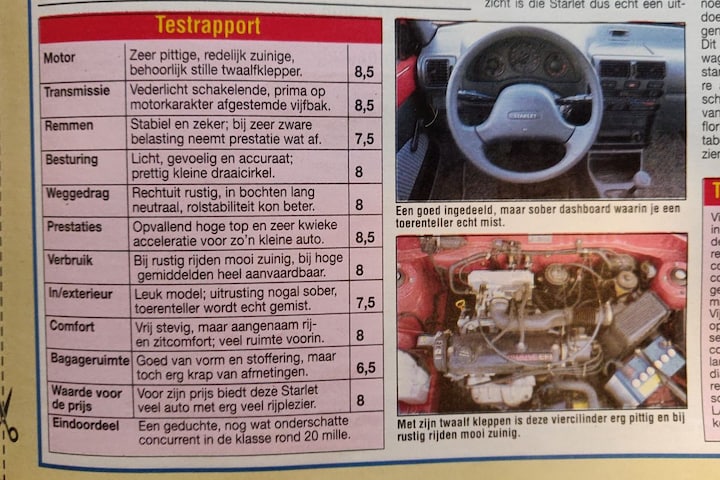The Toyota Starlet of the third generation; everyone probably still knows him. Tens of thousands of them were sold in our country and there are still quite a few on the road. Not without reason, of course. In 1991 we drove the 1.3 XLi and it already promised a lot for the years to come.
In 2020 we looked back every week at the Techzle from exactly 30 years earlier, on the occasion of our 30th anniversary. At the end of the year, that section also came to an end. The responses to it showed that many would miss the look back, so that’s why we are breathing new life into it in a slightly different form with ‘Uit de Oude Doos’. From now on we zoom in on one article and we kick off with a driving test of the Toyota Starlet. A car that many have owned, be it new or as cheap and reliable second-hand. All the more fun to see how one of Techzle’s first tests with the Starlet turned out.
That the third generation of the Starlet had the potential to become a success, is evident from the conclusions of the test editor. He was especially impressed by how the Japanese drove. Although small cars were often economical, you often lost driving pleasure. This was not the case for the Starlet: “It is not only small and economical, but also surprisingly fast.” The secret: the four-cylinder with twelve valves. For more pizzazz you stared your eyes blind at sixteen valves in the early 90s, but apparently Toyota managed to get a nice bright block with a notch less.

The Starlet was therefore already a pleasant car to drive at an attractive price, says the editor: “To a large extent, this complimentary assessment is due to the four-cylinder equipped with three valves per cylinder, which produces 75 hp from 1,300 cc. Also a maximum torque of 100 Nm is not wrong for such a small car, albeit that the corresponding speed of 4,200 is a bit high. the brewery. ” The 0-100 km / h acceleration in 10.7 seconds and a top speed of 172 km / h receive quite a lot of praise.
Another important aspect of a compact model like the Starlet, economy, was also good. At least, a test consumption of an average of 1 in 12 was described as ‘not bad at all’ and that included the comment that the Starlet had occasionally challenged to ‘kick hard’. A consumption of 1 in 14 to 1 in 16 was also estimated very feasible. Figures that would make you head over heels in such a small car nowadays, but for that time very well.

In terms of handling, the straight-line stability and direct steering response were particularly noticeable. In the corners, the Starlet was a bit more ‘neutral’ and not really distinctive. What made it feel a bit more dynamic, was the manual five-speed gearbox. It switched ‘the Japanese way’ nice and light and precise. Technically it was all well organized, which was also evident from the reliable reputation that this Starlet had for decades. In terms of design it was probably a little less spectacular. Although the exterior was a fresh appearance after the second model series, the dashboard in particular was a bit colorless and it was all a bit nicer than some competitors. The trunk also stood out in a negative sense; it did not excel in terms of space.
If you were convinced of the Starlet after reading our driving test in Techzle 5 of 1991, you could drive it yourself as an XLi for just over 20,000 guilders.